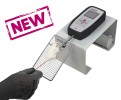Authors
E. J. Mientjes, R. Willemsen, L. L. Kirkpatrick, I. M. Nieuwenhuizen, M. Hoogeveen-Westerveld et al.
Lab
Erasmus University, Department of Clinical Genetics and Department of Pathology, Rotterdam, The Netherlands ; Baylor College of Medicine, Department of Molecular and Human Genetics, Houston, USA ; CNRS/INSERM/ULP, Institut de Genetique et de Biologie Mole
Journal
Human Molecular Genetics
Abstract
FXR1 is one of the two known homologues of FMR1. FXR1 shares a high degree of sequence homology with FMR1 and also encodes two KH domains and an RGG domain, conferring RNA-binding capabilities. In comparison with FMRP, very little is known about the function of FXR1P in vivo. Mouse knockout (KO) models exist for both Fmr1 and Fxr2. To study the function of Fxr1 in vivo, we generated an Fxr1 KO mouse model. Homozygous Fxr1 KO neonates die shortly after birth most likely due to cardiac or respiratory failure. Histochemical analyses carried out on both skeletal and cardiac muscles show a disruption of cellular architecture and structure in E19 Fxr1 neonates compared with wild-type (WT) littermates. In WT E19 skeletal and cardiac muscles, Fxr1p is localized to the costameric regions within the muscles. In E19 Fxr1 KO littermates, in addition to the absence of Fxr1p, costameric proteins vinculin, dystrophin and _-actinin were found to be delocalized. A second mouse model (Fxr1+neo), which expresses strongly reduced levels of Fxr1p relative to WT littermates, does not display the neonatal lethal phenotype seen in the Fxr1 KOs but does display a strongly reduced limb musculature and has a reduced life span of _18 weeks. The results presented here point towards a role for Fxr1p in muscle mRNA transport/translation control similar to that seen for Fmrp in neuronal cells.
BIOSEB Instruments Used:
Grip strength test (BIO-GS3)

 Pain - Thermal Allodynia / Hyperalgesia
Pain - Thermal Allodynia / Hyperalgesia Pain - Spontaneous Pain - Postural Deficit
Pain - Spontaneous Pain - Postural Deficit Pain - Mechanical Allodynia / Hyperalgesia
Pain - Mechanical Allodynia / Hyperalgesia Learning/Memory - Attention - Addiction
Learning/Memory - Attention - Addiction Physiology & Respiratory Research
Physiology & Respiratory Research
 Pain
Pain Metabolism
Metabolism Motor control
Motor control Neurodegeneration
Neurodegeneration Cross-disciplinary subjects
Cross-disciplinary subjects Muscular system
Muscular system General activity
General activity Mood Disorders
Mood Disorders Other disorders
Other disorders Joints
Joints Central Nervous System (CNS)
Central Nervous System (CNS) Sensory system
Sensory system
